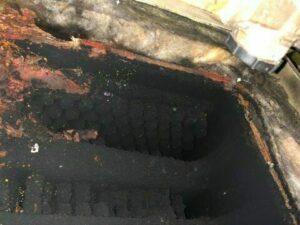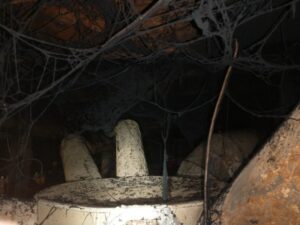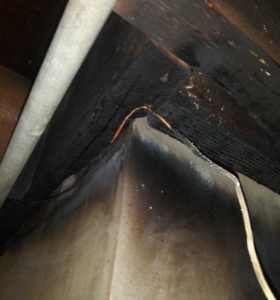Why Boiler and Furnace Puffbacks May Not Be Covered by Insurance
Colder months for some of your policyholders can get a little messy. During this time adjusters are likely to see an increase in claims that include furnaces and boilers because of puffbacks, which occur when heating systems turn on and could cause soot to go everywhere.
A puffback is an event in which a buildup of unburned fuel ignites and pushes back out of the burner section instead of burning cleanly into the burner area. Puffbacks can release smoke or soot throughout the heating equipment or into a forced air system’s ductwork. This could cause a lot of property damage, but it’s important adjusters know that puffback incidents most often stem from a non-covered loss.
Why Puffbacks Occur to Heating Equipment

Furnaces and boilers that use oil as their fuel source are more susceptible to puffbacks, though they can occur to those that run off gas too. The differences are the increased amount of maintenance required with oil furnaces and boilers and that excess oil is harder to dissipate than gas. Puffbacks in gas equipment are not very common.
Puffbacks are a sign that an issue exists within the system. Something has caused oil or gas vapors to build up within the heat exchanger and ignite when the system turns on. The force of all of it igniting at once causes the puffback, which could range in severity. Puffbacks could happen during one incident or every time the heating system starts, depending on what’s causing them.
Buildups of gas and oil typically occur because of a component not working as designed – and nearly all of them link back to wear and tear.
Causes of fuel buildup include:
- Leaks near the heat exchanger that lead to excess fuel getting in
- A policyholder manually resetting the system too often if it doesn’t start right away and leaving unburned fuel to accumulate
- A clogged burner full of dirt, dust, fuel residue, rust, or corrosion can cause a misfire and allow excess fuel in the heat exchanger, depending on the type of system
- A clogged or cracked fuel nozzle could cause incorrect amounts of fuel to enter the system. If there is too little, it will continue to spray, which could lead to the presence of excess fuel to burn when the system does successfully start
Another reason fuel can build up is from internal pressure irregularities, which lead to air and fuel imbalances. Components malfunctioning from wear and tear may cause this.

Explanations for internal pressure irregularities:
- Dirt, dust, fuel residue, rust, or corrosion can obstruct an exhaust or chimney and inhibit proper ventilation
- A cracked heat exchanger could keep combustion gases from venting out of the furnace. This could allow gases to get in the heat exchanger and cause an internal pressure irregularity
Why Aren’t Furnaces and Boilers Typically Covered After a Puffback?
Whether a puffback is covered by insurance depends on the carrier and the policy. For some policyholders, insurance may cover the repairs and replacements required for property affected by the soot and smoke. However, many policies won’t cover the malfunctioning heating system itself without mechanical or equipment breakdown coverage. That’s because most of the issues that lead to puffbacks are signs of poor maintenance or wear and tear, which policies don’t typically cover.
Prevention is possible through having regular furnace and boiler maintenance, scheduling routine cleanings to eliminate debris and buildup, replacing the oil filter to keep oil as clean as possible, paying attention to unusual leaks or noises, and using a carbon monoxide detector. Carbon monoxide typically increases when puffbacks occur and a detector can alert a policyholder.
If proper maintenance by an HVAC system expert isn’t completed, puffbacks may occur and result in a property claim.
Signs of Puffback Vs. Another Peril

It may not always be obvious whether the damaged HVAC system cause of loss was wear and tear or another peril, such as smoke and fire. Testing for a puffback can include evaluating for leaks, assessing for clogs, or performing a candle check, which is monitoring the flame of a lit candle held near a blowing heat exchanger.
However, a policyholder should never complete these actions to determine if a puffback occurred. They can be dangerous and so is this equipment if handled by an untrained person. It’s also important that an objective expert assess the damage to ensure the policyholder – and the carrier – is only making repairs and replacements that are required. This eliminates unnecessary claims leakage for a carrier and helps both the policyholder and carrier better understand the best course of action to return equipment to pre-loss condition.
HVACi is the nation’s leading damage assessment company for HVAC and Refrigeration equipment. Our trained, objective experts know what to look for when evaluating for a puffback or any other peril that causes equipment damage. We provide adjusters with comprehensive assessment reports in a short amount of time that include cause of loss, scope of damage, and repair and replacement recommendations as well as verify if the equipment is available and Like Kind and Quality. Don’t settle a claim for something that was caused by a non-covered peril. Submit a claim to HVACi for an accurate claim resolution.

